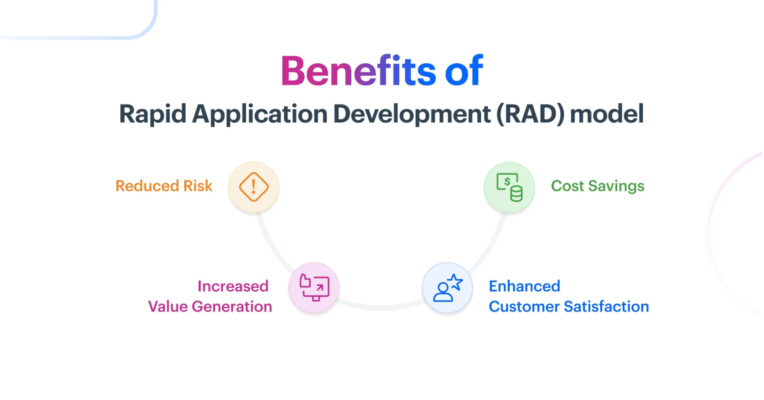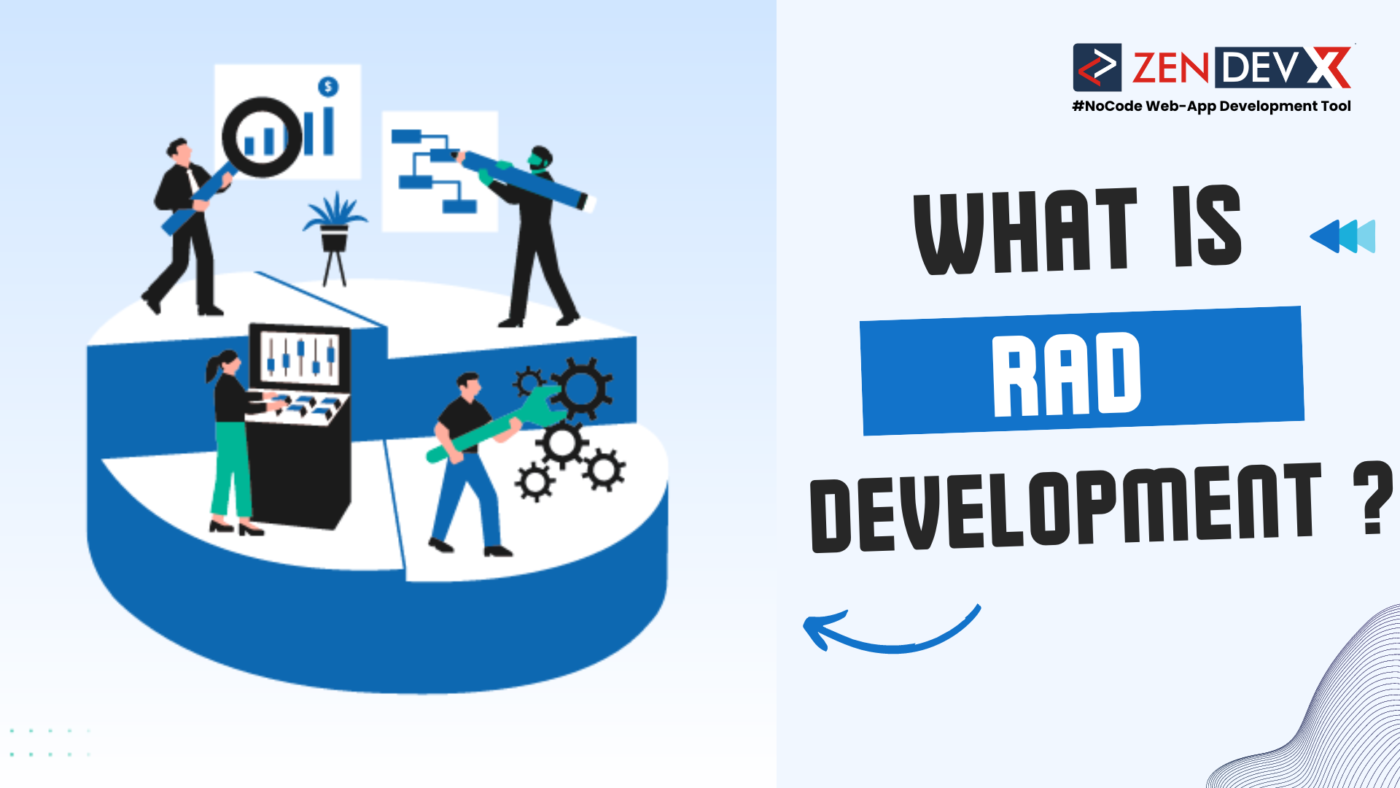In a time when CIOs push innovation nonstop and business technology partners support revolutionary IT projects; RAD is a great friend in the search for quicker, more efficient software development. The ever-changing field of software engineering has changed as we enter 2024, and RAD is likely to be quite important.
Rapid Application Development, or RAD, emphasizes prototyping and quick feedback based on which creates a flexible software development paradigm less dependent on particular planning. Generally speaking, the RAD method gives development and creating a prototype first priority above design. Rapid application development lets developers rapidly create several iterations and improvements to the program without beginning from nothing. This guarantees that the finished result more closely reflects quality and meets the needs of the end customers.
What is Rapid Application Development?
One of the main drawbacks of the waterfall model is that the tester cannot return once the product enters the testing stage to repeat and alter the fundamental features and functions. This basically leaves teams with software either fitting or not for the changing needs of end customers.
Since RAD was developed in the 1980s, it is most certainly not anything new. Still, it’s not single unlike the waterfall model. Development theories are always changing to fit the needs of that given era. From 2022 to 2027, the compound annual growth rate (CAGR) for the global market for Rapid Application Development is expected to be 42.8%. Barry Boehm, James Martin, and several others first observed that software transcended conventional engineering approaches. It was not one single resource needing a set framework. It could be molded to fit the user’s requirements.
Why Apply Rapid Application Development?
The greatest way to create prototypes quickly for testing software features free from concern for any impact on the final result is RAD. Companies choose the RAD technique since it lets the team build, review, and iterate features and capabilities fast while requiring little attention on the planning stage. At first, fast application development resembled the Spiral model, in which a specific project was worked on using one or more development models.
RAD stages have evolved throughout time. It kept some fundamental development rules while shaping itself to match the times. Driven by user interface objectives, the RAD method is ideal for application development needing fast development and implementation. RAD allows rapid and simple creation of software apps by use of visual interface tools and pre-built modules. Because of their agility, adaptability, and scalability, companies choose several forms of quick app development.
Steps in Rapid Application Development
RAD consists of four fundamental steps:
-
Describe the Criteria: RAD distinguishes itself from conventional software development approaches right from the start. It asks for a broad requirement instead of you sitting with end users and obtaining a comprehensive set of specifications. The general character of the criteria enables you to spend the necessary time segmenting particular requirements at several stages of the development process.
-
Prototyping: This is where development occurs. Developers produce prototypes with varying features and functions as quickly as they can, not adhering strictly to a set of criteria. These prototypes then are presented to the clients who determine their preferences and what they avoid. Usually, these prototypes are created fast to highlight simply the salient characteristics.
-
Construction: Engineers and developers put out much effort to translate a functioning model into a functional system. At this point, reviews and feedback are absolutely vital as most problems, flaws, and changes are handled. This step can be exceptionally protracted, particularly in situations when clients veer off course or provide intensive criticism.
-
Implementation: Implementing the created system into a live production environment comes last in RAD. Intensive scale testing, technical documentation, problem tracking, final customizing, and system simulation constitute the deployment phase. Before going live, teams also dedicate time performing last updates and maintenance chores and troubleshooting the app.
Advantages of Rapid Application Development

Rapid Application Development (RAD) is a software development technique where immediate feedback and rapid prototyping take front stage over protracted, drawn-out development and testing cycles. Accelerated development cycles of RAD help to provide general value for companies by:
- Faster Time-to-Market: RAD makes use of iterative development and prototyping, enabling quick delivery of practically usable software components. Faster product introduction by companies helps them gain a major competitive edge.
- Early Detection and Correction of Errors: Since RAD entails ongoing user input, mistakes and problems are found and fixed early in the development life. This lessens the time and effort needed for later on intensive debugging.
- User Involvement: Frequent release of minor features made possible by RAD not only keeps end users interested but also gives them instant value. Furthermore, as the end consumers participate all through the creation process, the finished product usually reflects their wants, therefore raising its whole value.
- Reduced Project Risk: RAD lowers the probability of project failures by stressing small-scale development. Every little change is controllable and easily tested, hence the likelihood of any serious problem compromising the whole project is much lowered.
- Enhanced Satisfaction: Involving users throughout the development process guarantees that the final product satisfies consumer expectations and needs. Higher client satisfaction resulting from this might inspire loyalty and retention of business.
- Interdisciplinary Cooperation: RAD advances interdisciplinary cooperation. It is a very cooperative paradigm designed to combine IT teams, corporate stakeholders, and end users. Delivery of the greatest possible product and alignment depend on this kind of cooperation.
Development of Rapid Applications Against Other Paradigms of Software Development
The RAD framework differs significantly from other approaches of software development. Clearly, the main distinction is how fast application development emphasizes speed when compared to other models, which often concentrate on delivering a working product to the user.
| RAD | Agile | Waterfall |
|---|---|---|
| Creates the fastest feasible functional model of the application. | Stresses thorough preparation and executes on stated goals. | Develops the app by dissecting big goals into more manageable “sprints”. |
| Ideal for projects needing the lowest completion times. | Projects are well thought out, and usually their execution takes time. | Aids in the development of projects using “sprints,” or periodic milestones. |
| Can modify to fit shifting needs. | Does not let modifications once the planning is finished. | Can rather quickly adapt to alterations even in later phases. |
| Interacts with clients all through the development process. | Involves clients just during the planning period. | Involves clients all through the development. |
| Gives utility above UI/UX aspects. | Thinks through every feature of the app before it launches. | UI/UX ranks equally with functionality in importance. |
When Should One Apply the Rapid Application Development Approach?
-
When you can consistently evaluate your prototypes: RAD is a fantastic technique to pursue if you have a pool of customers that can provide continuous and dependable feedback on the prototypes you create. Reliable feedback from trustworthy sources is quite beneficial since prototypes developed using the rapid application development paradigm depend on comments from past iterations.
-
When your budget is known: RAD is rather cheap when compared to other development approaches, although occasionally the RAD properties might cause expensive developments. Hiring gifted employees means you will have to pay them commensurate rates. The plus side is, if you have the manpower, you can get the idea from concept to end product far faster than other methods.
-
When you must have a project completed fast: RAD is your best bet if you have a strict deadline. Choosing a RAD platform can be the greatest option if you have to produce something that performs under duress. RAD software is your best choice if you lack the time to complete a thorough phase of requirement planning and design.
Case Study in Quick Application Development: Centric Consulting
Small companies who need software done fast and who have a lot of feedback during the development process can especially benefit from rapid application development. One of which had over 35,000 employees for procurement, invoicing, and payment, Central Consulting, a developer experienced with agile development approaches and rapid application development, had a client come to them with a need for software that would connect with their clients. Using agile and rapid application development approaches, Centric Consulting was able to rapidly grasp what the customer needed, accelerate the development process using Ruby on Rails, and maintain low costs using fast application development open source infrastructure. The client was allowed to offer comments on what needed to be functional throughout the development process. As and when they were needed, all those features were quickly incorporated; finally, the product was given to the customer. Ultimately, Centric Consulting not only satisfied its clients’ expectations but also developed its company by meeting those objectives.
Often Asked Questions (FAQs)
What does RAD refer to?
Focusing on creating a working prototype in the shortest possible time, RAD is a very flexible method of app development. The philosophy stresses more on the development on the fly than on a comprehensive, regimented plan since it accepts the evolving character of customer needs.
What is Rapid Web Application Development?
Rapid web application development is a technique for application development stressing effectiveness and speed in producing online apps. Usually, it entails applying agile development methods including incremental development and prototyping as well as pre-built, reusable code libraries and frameworks. RWAD aims to minimize the time and expenses involved with creating web apps while also generating excellent, useful software.
How does Rapid Application Development proceed?
Four phases or components—requirement collecting, fast prototyping, building, and deployment—make up the general framework of fast application development. Stakeholders talk on the high-level application needs. Teams collaborate to create a workable prototype of the application rapidly prototyping. Teams endeavor to translate the beta model into a useful, operational system. The app enters a production setting following scale testing and documentation.
Where might one apply the RAD model?
When app development especially asks for rapid development and deployment, RAD is ideal. When:
- The initiative calls for a flexible strategy.
- Apps have to be created fast.
- One must make progress clear-cut visible.
- Clients should participate in the evolution.
- One can easily get user comments.
- Technical risk is not significant.
Using RAD, what are some applications one might create?
For medium-sized applications that need to be routinely updated to maximize efficiency and are not high-risk, fast app development is ideal. Among these are some:
- IT support desk staff onboarding
- Performance Reviews
- Reversals for expenses
- Creative inquiries
What does quick framework imply?
Comprising libraries, techniques, classes, and reusable objects based on the fast application development concept, fast frameworks enable developers to save time. By doing away with the necessity to design libraries and from-scratch approaches, frameworks save time.
RAD and JAD: Differentials
An agile process called Rapid Application Development (RAD) gives quick prototyping and feedback top priority for software iterations focused on quality. Designed for rapid product creation in the always changing digital terrain, In seminars, Joint Application Development (JAD) is a group effort including corporate representatives, tech professionals, and stakeholders. For effective, customized end goods, it combines customer feedback into the development process.


